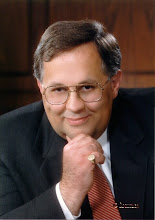In February 1971, I met with then President Richard Nixon to discuss a report co-authored by me on the Progress of Vietnamization.

This was the name given to a program, begun by this President, that provided American styled basic military training to young Vietnamese men who became members of the Army of the Republic of Vietnam (ARVN). Once trained, new ARVN units would replace American units that would then be brought home. In a sense it is similar to the training provided by U.S. forces right now in Iraq and Afghanistan.
Yes, that is a picture of the author (above) with the President and then Assistant National Security Advisor, General Alexander M. Haig, Jr., in the Oval Office.
During the meeting, the President addressed criticism he had received over prolonging the war. He said that he was trying to extract U.S. troops in a way that would give the South Vietnamese a better chance to defend themselves and made the point that he was not a warmonger. The President then turned and asked Press Secretary Ron Ziegler how many men were killed that week. Ziegler said 32. Mr. Nixon then said, "It's always a number. When I came here the number was in the hundreds, always a number." "Yet, I'm a politician," the President continued, "and if there is one thing I know is that they are not numbers, they are men."
The President went on to say that he had a theory that by the time a man is 18, 19, 20, he has touched the lives of at least 2,000 people --- his elementary and high school classmates, cub scouts, boy scouts, little league, family, friends, neighbors, church members, they all add up. So while 32 men may have died in Vietnam that week, the President said, 64,000 Americans have been personally and painfully impacted by the war.
Ever since that meeting I have called this observation, the Nixon factor of how war can impact a nation. When you apply it to the War in Vietnam with 211,501 casualties (58,198 dead and 153,303 wounded), the Nixon factor indicates that 423,002,000 Americans were personally impacted, some more than once. Since that number exceeded the population at that time, it is fair to say that most every citizen was personally touched by the war.
When you apply the Nixon factor to the War in Iraq and Afghanistan with 38,960 casualties (4,953 dead and 34,007 wounded as of 4/24/2009), the results find that some 77,920,000 Americans have been personally impacted.
Something to ponder when those in power consider sending young American men and women in harms way.







Willie - Thanks for sharing your insight and experience. You may recall that when we first got to Manhattan College, Nixon came to speak (I think just prior to his election). We were freshmen. I visited Paco this February and reminded him of this story. Manhattan College actually put down red carpet the night before this honored speaker's arrival. Paco went in later that same night, rolled it back up, cut it up and carpeted the halls of Chrysostum dormitory. While I don't regret that Nixon lacked the red carpet, I do regret that I didn't bother to listen to what he had to say - a lost opportunity for me.
ReplyDeleteAs you say, the Vietnam War touched us all and I know we overlap our experiences on a couple of young men who were tragically lost. I have a self portrait that Chris Meagher did indicating what he would have looked like if he grew to be an old man. I will send you that image as you would probably appreciate just how much talent was lost in this one instance. Then consider that 58,198 were lost.
It would be wonderful if no more Americans were ever put in harms way due to some conflict. I just finished an excellent, but extremely depressing, book by Robert Fisk ("The Great War for Civilisation") that chronicles the last 100 or so years of blood shed in the Middle East. There is no good or wise behavior or policy to be found by anyone.
Biz